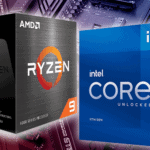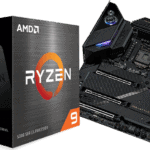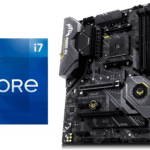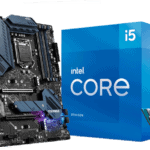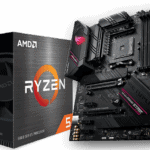Our Best Motherboard CPU Combos (Intel & AMD) – What’s The Best in 2022?

It’s a constant one-up-manship in the world of CPUs, with numbers flung at both Intel and AMD from all sides with no signs of stopping any time soon. AMD seems to have the upper hand, but the new Intel 11th generation CPUs are absolutely holding their own. So what’s best for you? Are you going all-in for gaming? Maybe you’re on a budget? Either way, we’ve got the best combinations to make your life as easy as possible.
We also have guides for the best Motherboards and CPUs for getting into Windows 11 if it’s time for you to upgrade!
Products at a Glance
Our Best Motherboard CPU Combos (Intel & AMD) – What’s The Best in 2022?
- Great investment
- PCIe 4.0
- Superb gaming performance
- Incredible content creation performance
- Very expensive
- Gaming performance tops out at some point
- Danger zone with overclocking
Let’s talk AMD first because as of right now, it’s the best on the market when bang for buck comes into the conversation. The Ryzen 9 5900X and 5950X are the top dogs in this case providing obscene performance in both content creation and gaming.
If you don’t want to go in on the several thousand needed to buy a Threadripper, the 59XXX series of CPUs are absolutely the ones to go for. Speed-wise, you’re getting a ludicrous 3.4GHz that boosts to 4.9GHz, with a total of 16 cores that when compared with an equivalent Intel i9, uses a lot less power – and a lot less of a cost.
The $799 price tag might be a hard pill to swallow (which is where the slightly weaker 5900X comes in), but this is an investment. I wouldn’t expect to see anyone upgrade this CPU for a fair few years now, with its support for PCIe 4.0 and power not fading to obscurity any time soon.
While you won’t see a massive difference between the 5900X and 5950X on gaming, it’s the content creation where it edges out everything. Unless you’re willing to jump to the Threadripper, this will serve you valiantly.
But to pair this? We need an AM4 socket motherboard and one worthy of providing us with all the trimmings. So we’re going for the ROG Strix X570-F Gaming board, with its hideous design aside, does give us a great set of I/O, with 3 USB-A and 1 Type-C, all rated at 3.2 Gen 2 for fast transfer speeds, as well as slots for 2 M.2 Drives, 4 slots for RAM and HDMI 2.0 for 4K gaming.
- Super small
- Massive power packed in
- i7 is great for content creation and gaming
- Potential for overheating
- ITX can be fiddly
In fact, we’re not even going to be moving away from this board as it fits all our needs for pretty much anything we want to do. For the next CPU, we’re going to be looking at the 5600G, a super powerful APU, which for light gaming and emulation, doesn’t actually even need a graphics card with it. You just need to have the APU set up and off to the races with you!
Priced at around $250, the 5600G is a genuinely great entry-level CPU that fits directly into those looking for a budget build that doesn’t really limit them. You can always add a GPU after the fact, but having this as a base is ideal for those that want to get into PC gaming.
It won’t blow you away with impressive 4K gaming, but for a quick way to get solid 1080p performance and room to expand once you have the cash – and availability is a thing again – this gets the thumbs up!
- Best price for performance on Intel's 11th gen
- Not overly expensive
- Access to Thunderbolt 4
- PCIe 4.0
- WiFi 6 and 2.5Gb Ethernet
- Still quite expensive for mid-tier gear
- Absolutely needs a graphics card
- Won't do too hot under intense loads
- Overclocking could break the device
For Intel, we’re going to do something a little different, but if you want to apply the same theories here to any AMD chips, just make sure you’re getting the right sockets for the CPU, but this should be plastered all over the branding anyway.
Intel’s latest CPUs, the 11th Generation in their current lineup, is incredibly powerful and nothing to sniff at! They do single-threaded tasks better than AMD but often come with a hefty brand recognition price tag with it. While they’re not entirely keeping up with AMD in terms of technology, they still make for great CPUs – especially as they all come with integrated graphics onboard for more budget-focused, office builds.
We’ll of course be recommending you the best for gaming with this one – but with a catch. As I’m a huge fan of smaller form factor PCs, this system might seem a bit weaker, but it’ll actually still perform exceptionally when everything is crammed together in the chassis.
First, we’re going to say that you go for the i5 11600, with no real need to overspend on this recommendation, just go for what you need and not what you want. You’ll thank us later when your PC isn’t suddenly on fire or you need to figure a way to cram in more cooling.
The 11th generation of Intel CPUs hasn’t had the best of times in any reviews and such, with no massive performance gains, but bringing with it some new features. Want PCIe 4.0? Well, you’ll need to upgrade or build from this point onwards.
So don’t overspend on this generation of Intel chips, but go for the all-rounder and you’ll be fine. The nice thing about this is that it fits delightfully on the B560, a PCIe 4.0 enabled motherboard that is really small. Not only are you getting the full whack of power out of the i7 chip, but WiFi 6, 2.5GB Ethernet, and a bunch of I/O to make sure you’re never caught out with your devices. It’s pretty much future-proofing your PC for the inevitable upgrades around the house and you won’t be experiencing disconnected WiFi for a while with the additional aerial.
- Perfect entry level
- APU surprisingly well equipped
- Great for gaming and emulation
- Cheap
- Room to expand
- Hard limits with an APU
- Trapped at 1080p for performance
- Will get usurped before too long
Keeping with the tiny theme, the Z590-I is the chef’s kiss of tiny motherboards at the moment. Thunderbolt 4, complete with the similar specs of the previously mentioned B560, is your creme-del-a-creme of boards. Sure, it’s a bit of an overkill, but who doesn’t like a Napoleon Complex now and then?
So with a great board that will fit in most ITX builds, what do we pair with it? Well, we could go with the i9-11900K, but let’s be frank: price for performance? Absolutely not worth it. Instead, let’s slot in an i7 11700K, a beefy CPU with optional overclocking available (that’s what the K is for!). This combination will give you an immensely powerful tiny box that can do not only the harshest and most intense tasks without breaking the bank, but perform wonderfully with all those new and tasty games you’ve got locked away in your Steam account.
If I Buy A New Motherboard, Can I Keep My Old Components?
Sure can! Once you’ve replaced the motherboard refit everything into its slot and off you go!
Make sure your parts match specification, don’t be putting DDR3 RAM in DDR4 slots, and make sure you have a Windows 11 supported CPU going back in too.
Our Verdict
